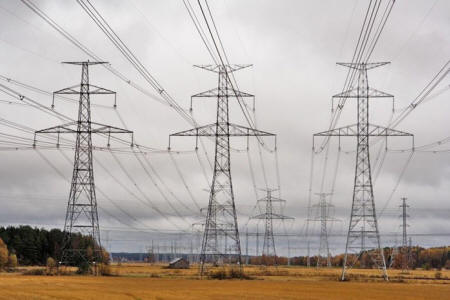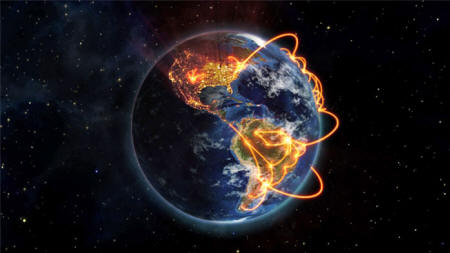|
|
|
from Gigaom Website
everyone will be connected - everywhere, all the time - making space and time no longer an issue for physical devices, people and products.
Which modern technology,
If you answered "the internet," you're right. If you answered "the telephone," "the television" or any other speed-of-light telecommunication technology, you're also right.
That quote is from an 1860 book by George Bartlett Prescott, an American telegraph official.
In 1860, the fastest telecommunication link between California and New York was the Pony Express, which took at least 10 days to get a message to the other side of the continent. Then one day in 1861, the First Transcontinental Telegraph was completed and you could send the same message across the continent in 10 seconds.
Two days later, the Pony Express officially ceased operations. Prescott was onto something.
The Ancient Greek word "tele" means "far away". To telecommunicate is to communicate farther than you can shout.
When you connect two points with a speed-of-light telecommunication channel, you annihilate the spacetime-distance between the points. You get a kind of wormhole.
The internet is a network of spacetime wormholes connecting every human being on the planet. If you want to chat with someone face to face, you just stare into your cell phone and they stare into theirs. You can't tell if they're a thousand miles away, or in the next room.
But when it comes to physical things, we're still living under the tyranny of spacetime.
Kevin Ashton, the inventor of the term "Internet of Things", wrote in 1999:
Just look around the room right now, at anything other than your cell phone.
All the things you can see and touch depend on where you are in space, or on how much time you spend moving yourself to a new location.
That's a problem, because at any given moment, most of the things you care about aren't in your line of sight. Almost none of the food you're going to eat that day is. Almost none of the appliances you're going to use that night are.
That's the tyranny of spacetime, which the internet of things is now beginning to overthrow.
The internet of things has three major spacetime-annihilating functions:
Transportation
In the past, far away things had no way to know what you wanted from them or when you wanted it.
The right things wouldn't know how to find you. So you'd have to travel to where the things were - to a restaurant, to your house, to various stores.
If you shop on Amazon instead of going to the store, you're on the internet of things.
Last year, Amazon acquired robotic warehouse technology company Kiva systems. When you one-click on that toothbrush, Amazon's robots move it from deep inside the warehouse onto the floor where employees pack it and ship it to you.
The internet of things transports things to you pretty fast, but not at the speed of light. It uses the internet's fast-moving bits the way skydivers use a little pilot chute to pull out a bigger, heavier parachute.
Teleportation
Actually, sometimes the internet of things does make faraway things come you at the speed of light. The trick, called "teleportation", is to convert things to bits and then back to things again.
The first teleporters were invented before the internet, but the far away "facsimiles" they brought you were just pieces of paper. Modern teleporters are a lot more versatile.
The MakerBot Digitizer can scan 3D objects and store their structure as a file of bits. The MakerBot Replicator can read a file of bits and print a 3D object. Put the Digitizer and Replicator at opposite ends of an internet connection and you get a teleporter.
Thousands of objects can already be teleported at the speed of light - silverware, vases, lamp frames, and even some weird-looking, but functional shoes.
Soon the internet will be able to teleport physical objects into your lap as easily as it teleports web pages into your screen, and you'll be able to surf the internet of things.
Telepresence
Sometimes you want to interact with far away things without having them transport or teleport to you. Then what you want is telepresence.
For example, you often move far away from your locked bike. Normally that means you can't unlock your bike to let a friend borrow it, and you also don't know when thieves are cutting your lock.
LOCK8 is a smart bike lock that lets you unlock it from far away, and notifies you when a potential thief is tampering with it. No matter how far away you are from your bike lock, LOCK8 gives you all the benefits of being near your bike lock.
What if you're far away from your office, but still want to attend meetings as if you weren't? Virtual presence systems like Anybots and Suitable Technologies' Beam let you remote control a walking, talking, seeing, hearing robot.
You can travel halfway around the world, and still have a physical presence at your office.
The future - The internet of everything
Did you know you have two wireless modems in your head?
Your eyes constantly receive radio signals in the visible spectrum, and your sense of vision connects your brain to nearby physical things, like a de facto Local Area Network. But your sensory LAN connection only extends as far as your line of sight. It's nothing compared to a Wi-Fi internet connection.
In the future of the internet of things, Wi-Fi is going to be everywhere, and the internet will connect you to every person and thing on the planet via transportation, teleportation and telepresence.
A trillion wormholes will let you reach out from anywhere on earth and hug your loved ones, or try on a new pair of shoes, or unlock your bike.
In the future beyond the internet of things, all your senses will be wired directly into the internet's wormholes, and you'll be completely indifferent to the location of your physical body.
When you look around you, you won't be looking into a nearby region of space.
You'll be surfing an internet that annihilates all time and space - the internet of everything.
|




